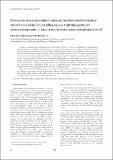Files in this item
Estimating pollinator performance of visitors to the self-incompatible crop-plant Brassica rapa by single visit deposition and pollen germination : a comparison of methods
Item metadata
| dc.contributor.author | Patchett, Robert Brian | |
| dc.contributor.author | Ballantyne, Gavin Andrew | |
| dc.contributor.author | Willmer, Patricia Gillian | |
| dc.date.accessioned | 2017-12-11T11:30:14Z | |
| dc.date.available | 2017-12-11T11:30:14Z | |
| dc.date.issued | 2017-12-01 | |
| dc.identifier | 251414004 | |
| dc.identifier | 6846efc6-49a7-43be-9499-2813b32d9ded | |
| dc.identifier.citation | Patchett , R B , Ballantyne , G A & Willmer , P G 2017 , ' Estimating pollinator performance of visitors to the self-incompatible crop-plant Brassica rapa by single visit deposition and pollen germination : a comparison of methods ' , Journal of Pollination Ecology , vol. 21 , no. 3 , pp. 78-85 . < http://www.pollinationecology.org/index.php?journal=jpe&page=article&op=view&path%5B%5D=420 > | en |
| dc.identifier.issn | 1920-7603 | |
| dc.identifier.uri | https://hdl.handle.net/10023/12310 | |
| dc.description.abstract | Estimating the pollen-deposition effectiveness of flower visitors is fundamental to understanding their performance as pollinators. While estimates of visitation rates, pollen loads, and single visit deposition (SVD) are all useful proxies for performance, and so help to reveal the relative effectiveness of different visitors, none take into account the breeding system of the plants, or the quality of pollen deposited. Here we compare the performance of visitors to the self-incompatible plant Brassica rapa (turnip) using SVD and pollen germination. We also report the first use of the staining of Brassica rapa stigma papilla cells (known to reveal a specific reaction to self-pollen) to compare self-pollen deposition between insect visitors. We found that most of the pollen grains deposited by insect visitors (and therefore counted by SVD methods) were non-germinating self-pollen. A smaller proportion of grains were outcrossed and so germinated. There was also a significant positive relationship between environmental conditions (wind speed) and pollen deposition, but not pollen germination. Both methods identified Bombus spp. as the best-performing visitors on turnip flowers, followed by Eristalis spp., whereas performance estimates for Episyrphus balteatus and ‘other hoverflies’ were no higher than controls for both methods. This study provides further insight into the methodology for estimating pollinator performance, especially in plants when only cross-pollen can germinate. | |
| dc.format.extent | 8 | |
| dc.format.extent | 1160266 | |
| dc.language.iso | eng | |
| dc.relation.ispartof | Journal of Pollination Ecology | en |
| dc.subject | Pollination | en |
| dc.subject | Pollinator effectiveness | en |
| dc.subject | Pollen deposition | en |
| dc.subject | Pollen germination | en |
| dc.subject | Brassicaceae | en |
| dc.subject | QH301 Biology | en |
| dc.subject | SB Plant culture | en |
| dc.subject | NDAS | en |
| dc.subject.lcc | QH301 | en |
| dc.subject.lcc | SB | en |
| dc.title | Estimating pollinator performance of visitors to the self-incompatible crop-plant Brassica rapa by single visit deposition and pollen germination : a comparison of methods | en |
| dc.type | Journal article | en |
| dc.contributor.institution | University of St Andrews. School of Biology | en |
| dc.contributor.institution | University of St Andrews. Scottish Oceans Institute | en |
| dc.contributor.institution | University of St Andrews. Institute of Behavioural and Neural Sciences | en |
| dc.contributor.institution | University of St Andrews. St Andrews Sustainability Institute | en |
| dc.description.status | Peer reviewed | en |
| dc.identifier.url | http://www.pollinationecology.org/index.php?journal=jpe&page=article&op=view&path%5B%5D=420 | en |
This item appears in the following Collection(s)
Items in the St Andrews Research Repository are protected by copyright, with all rights reserved, unless otherwise indicated.

